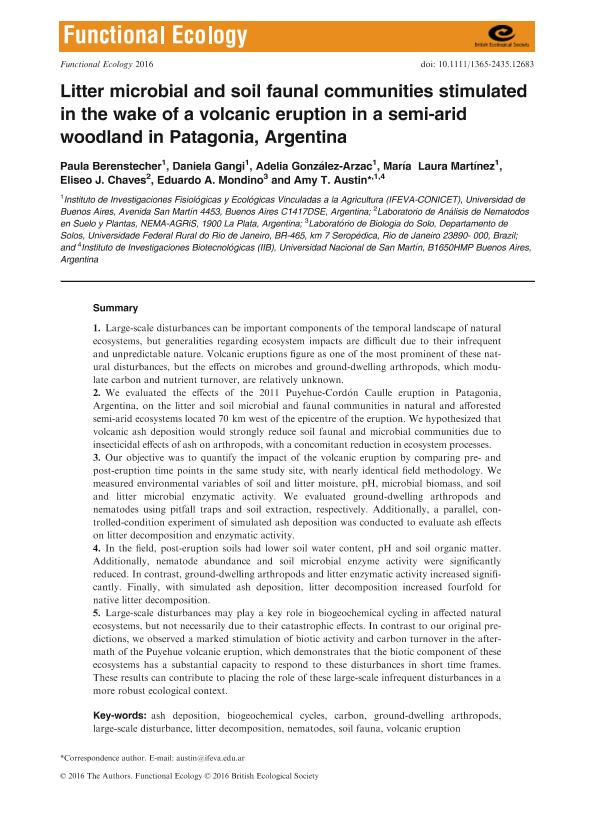Artículo
Litter microbial and soil faunal communities stimulated in the wake of a volcanic eruption in a semi-arid woodland in Patagonia, Argentina
Berenstecher, Paula ; Gangi, Daniela; González Arzac, Adelia
; Gangi, Daniela; González Arzac, Adelia ; Martínez, María Laura
; Martínez, María Laura ; Chaves, Eliseo Jorge; Mondino, Eduardo A.; Austin, Amy Theresa
; Chaves, Eliseo Jorge; Mondino, Eduardo A.; Austin, Amy Theresa
 ; Gangi, Daniela; González Arzac, Adelia
; Gangi, Daniela; González Arzac, Adelia ; Martínez, María Laura
; Martínez, María Laura ; Chaves, Eliseo Jorge; Mondino, Eduardo A.; Austin, Amy Theresa
; Chaves, Eliseo Jorge; Mondino, Eduardo A.; Austin, Amy Theresa
Fecha de publicación:
01/2017
Editorial:
Wiley Blackwell Publishing, Inc
Revista:
Functional Ecology
ISSN:
0269-8463
e-ISSN:
1365-2435
Idioma:
Inglés
Tipo de recurso:
Artículo publicado
Clasificación temática:
Resumen
Large-scale disturbances can be important components of the temporal landscape of natural ecosystems, but generalities regarding ecosystem impacts are difficult due to their infrequent and unpredictable nature. Volcanic eruptions figure as one of the most prominent of these natural disturbances, but the effects on microbes and ground-dwelling arthropods, which modulate carbon and nutrient turnover, are relatively unknown. We evaluated the effects of the 2011 Puyehue-Cordón Caulle eruption in Patagonia, Argentina, on the litter and soil microbial and faunal communities in natural and afforested semi-arid ecosystems located 70 km west of the epicentre of the eruption. We hypothesized that volcanic ash deposition would strongly reduce soil faunal and microbial communities due to insecticidal effects of ash on arthropods, with a concomitant reduction in ecosystem processes. Our objective was to quantify the impact of the volcanic eruption by comparing pre- and post-eruption time points in the same study site, with nearly identical field methodology. We measured environmental variables of soil and litter moisture, pH, microbial biomass, and soil and litter microbial enzymatic activity. We evaluated ground-dwelling arthropods and nematodes using pitfall traps and soil extraction, respectively. Additionally, a parallel, controlled-condition experiment of simulated ash deposition was conducted to evaluate ash effects on litter decomposition and enzymatic activity. In the field, post-eruption soils had lower soil water content, pH and soil organic matter. Additionally, nematode abundance and soil microbial enzyme activity were significantly reduced. In contrast, ground-dwelling arthropods and litter enzymatic activity increased significantly. Finally, with simulated ash deposition, litter decomposition increased fourfold for native litter decomposition. Large-scale disturbances may play a key role in biogeochemical cycling in affected natural ecosystems, but not necessarily due to their catastrophic effects. In contrast to our original predictions, we observed a marked stimulation of biotic activity and carbon turnover in the aftermath of the Puyehue volcanic eruption, which demonstrates that the biotic component of these ecosystems has a substantial capacity to respond to these disturbances in short time frames. These results can contribute to placing the role of these large-scale infrequent disturbances in a more robust ecological context. A Lay Summary is available for this article.
Archivos asociados
Licencia
Identificadores
Colecciones
Articulos(IFEVA)
Articulos de INST.D/INV.FISIOLOGICAS Y ECO.VINCULADAS A L/AGRIC
Articulos de INST.D/INV.FISIOLOGICAS Y ECO.VINCULADAS A L/AGRIC
Articulos(IIB)
Articulos de INSTITUTO DE INVESTIGACIONES BIOLOGICAS
Articulos de INSTITUTO DE INVESTIGACIONES BIOLOGICAS
Citación
Berenstecher, Paula; Gangi, Daniela; González Arzac, Adelia; Martínez, María Laura; Chaves, Eliseo Jorge; et al.; Litter microbial and soil faunal communities stimulated in the wake of a volcanic eruption in a semi-arid woodland in Patagonia, Argentina; Wiley Blackwell Publishing, Inc; Functional Ecology; 31; 1; 1-2017; 245-259
Compartir
Altmétricas



